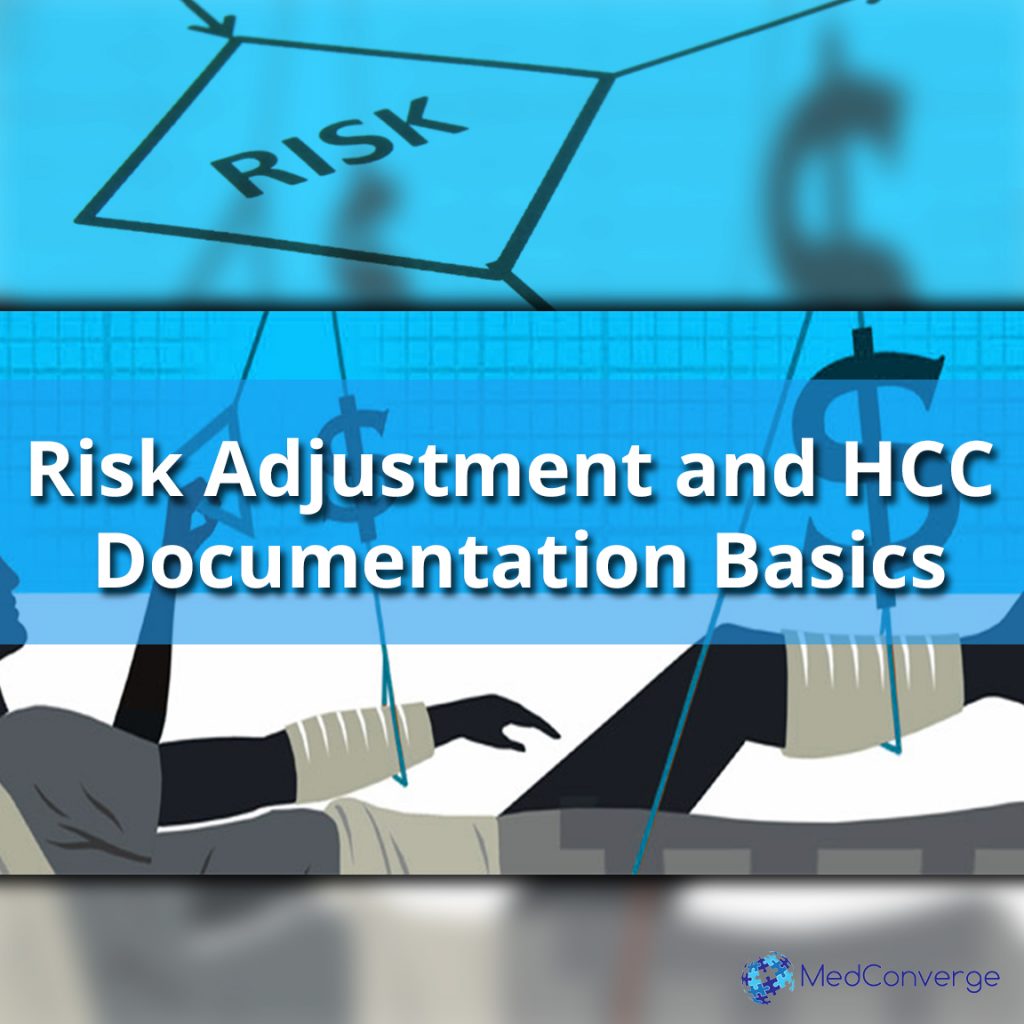With healthcare reform and system changes underway, accurate medical documentation and coding is critical to the financial health of your practice and to the health of your patients. In 2004 Medicare implemented an HCC (Hierarchical Condition Categories) model to adjust capitation payments to private health care plans for the health expenditure risk of their enrollees. The Centers for Medicare and Medicaid (CMS) Risk Adjustment Model measures the disease burden that includes 70 HCC categories, which are correlated to diagnosis codes. CMS’ model is accumulative, meaning that a patient can have more than one HCC category assigned to them. Some categories override other categories and there is a hierarchy of categories. Diagnoses from the previous year are used to establish capitation payments to the MA plan. The HCC must be captured every 12 months for CMS to reimburse the MA plan. It all boils down to the data collection process, which of course always points back to the physician’s office and the documentation of the patient encounter.
What is risk adjustment?
Risk adjustment is a process used by Centers for Medicare and Medicaid Services (CMS) to predict healthcare costs based on the relative risk of enrollees within a health plan to protect against potential effects of adverse selection. Risk adjustment is not a new concept. Medicaid began using risk adjustment modeling in 1996 and Medicare Advantage plans have been using the risk adjustment model since 2004. CMS is now looking to commercial plans to implement risk adjustment as a valuable method to identify and prepare for high‐risk patients.
What is Commercial Risk Adjustment?
Commercial Risk Adjustment (CRA) is one of three new premium stabilization programs, established by the Affordable Care Act (ACA), for the individual and small group commercial markets for products sold on and off the exchange. CRA encourages health plans to focus on quality improvements, efficiency and the stabilizing of premiums designed to prevent adverse selection.
How does the Commercial Risk Adjustment Program Work?
CMS is responsible for operating the risk‐ adjustment programs, reviewing each health plan’s claims data for the calendar year to establish an overall “risk factor” for the health plan. The “risk factor” is determined based on diagnosis coding supported by medical record documentation. CMS validates the health plan’s risk factor through medical record chart audits. Risk scores for the health plan will be adjusted as necessary.
What is Hierarchical Condition Category (HCC)?
Disease groups, organized into body systems or similar disease processes, are referred to as HCCs. CMS and The Department of Health and Human Services‐HCC model, (HHS‐HCC) includes both diseases and demographic factors, called coefficients. These models are cumulative; therefore, a patient may be assigned to more than one category. However, CRA uses a hierarchical system in which some HCCs will override other related conditions (only one HCC in a category may be assigned).
Top Hierarchical Condition Categories
- Major Depressive and Bipolar Disorders
- Asthma and Pulmonary Disease
- Diabetes
- Specified Heart Arrhythmias
- Congestive Heart Failures
- Breast (Age 50 plus) and Prostate Cancer
- Drug Psychosis/Dependence
- Rheumatoid Arthritis
- Colorectal, Breast (Age < 50), Kidney
- Coagulation Defects
Why Coding Matters
Coding has three key areas of impact:
- Inclusion of chronic conditions considered in the medical decision making for the Evaluation and Management (E&M) will allow for better health management.
- Complete patient diagnosis coding allows the member to be included in any number of quality management programs offered by Blue Cross and Blue Shield of Louisiana.
- Complete and accurate coding practices can minimize your administrative burden of additional paperwork later (i.e.‐ no need for health insurance company to request medical records).
Importance of Risk Adjustment Coding
CMS requires health plans to report complete and accurate diagnostic information on their members. These health plans must verify through medical records, that the reported diagnostic information is correct and accurate. It is important to remember that appropriate diagnosis code reporting and complete clinical documentation by the provider increases the accuracy of a member’s risk score while reducing the need to request medical records and/or audit our provider’s claims.
Risk Adjustment Guidelines
All diagnosis taken into consideration in the medical decision making for the visit should be included on the claim and in the medical record and specific diagnoses must be documented in a face‐to‐face visit by the treating licensed provider and the documentation must be signed by the treating provider to be accepted.
Documentation Basics
Each page of the patient’s medical records should include the following:
- The patient’s name
- Date of birth or other unique identifier (on the first page)
- Date of service including the year
The provider’s signature must be legible and include credentials. Legibility issues can be solved with a preprinted signature/credential block and a handwritten signature above the printed one. Electronic signatures should include the date and time of authentication, the servicing provider’s name and credentials and include a statement such as “Electronically signed by” or “Authenticated by.” It is important to be very clear on what diagnoses or conditions are current or ongoing instead of those that are no longer present or historical. Diagnoses that are not being treated but are current and ongoing for monitoring should be documented as current. All monitoring efforts should be included in medical documentation. Every current diagnosis being taken into consideration toward a medical decision should be documented in each visit as current and not documented as “historical.”
Coding & Documentation:
Documentation of diagnoses must be specific. This is important not only for Risk Adjustment programs, but also for ICD‐10 implementation efforts. Comorbidities and other modifying factors should be clearly documented. For example, some of the most commonly under‐diagnosed conditions are diabetes and hypertension.
Common errors need to be avoided. For example, chronic or coexisting conditions are not documented or are left out of the clinical documentation for an office visit. Similarly, discrepancies exist between the medical records and the reported diagnosis codes. Some other common errors are :
- The historical status of a diagnosis is unclear.
- The electronic health record was not authenticated.
- The record contains nonstandard abbreviations or up and down arrows to indicate diagnoses.
- Non‐specific diagnosis codes are used.
- Unlisted diagnosis codes (NEC/NOC).
- The use of quantifying language in the outpatient setting, (e.g. “Consistent with, probable, possible…”).
- Patient status conditions are not evaluated and/or documented at least once a year.
- A cause and effect relationship between diabetes and diabetic manifestation codes is not sufficiently documented and/or coded.
- The highest degree of diagnosis code specificity was not assigned or utilized.
Coding & Medical Record
The following requirements are a must:
- Encounter must be based on a face‐to‐face visit.
- Condition(s) must be documented in the medical record.
- Diagnosis cannot be inferred test results
- Diagnosis code can be assigned to each condition documented on the record.
- Documentation must show that condition was monitored, evaluated, assessed or treated (MEAT).
- Treatment and level of care must be justified.
- Health status assessed.
- All chronic conditions must be assessed and reported no less than once a year.
- Medical record must support codes reported on the claim or encounter form.
Providers have to report all diagnoses (not just primary diagnosis) that impact the patient’s evaluation, care and treatment including:
- Main reason for visit
- Co‐existing acute conditions
- Chronic conditions (such as CHF, CKD, RA, COPD/Asthma, Cardiomyopathy)
- Care rendered
- Conclusion and diagnosis
“History of” or “past” conditions
“History of” means the patient no longer has the condition. Frequent documentation errors regarding use of history of include coding a past condition as active and/or coding history of when condition was still active. However the exception to this error is when documenting some status conditions (e.g. Amputation).
Annual Evaluation
All relevant diagnosis codes should be reported at least once a year for each patient. The patient’s diagnosis code information is reset on January 1 of each year, in preparation for a new year of diagnosis encounter data. Annual evaluation, documentation and submission of all relevant diagnoses and corresponding diagnosis codes are important for:
- Promoting quality patient care
- Ensuring appropriate screening tests are received
- Ongoing assessment of the patient’s chronic conditions
- Accurate patient risk score calculation
- Data validation audits
Are you managing your claims effectively? Download the whitepaper for Tips on Reducing Claims Denials.
References
- Anderson, B. (2016). Risk Adjustment & Hierarchical Condition Categories Documentation Basics. Retrieved October 21, 2016, from www.securityhealth.org: https://www.securityhealth.org/providers/provider-manual/shared-content/claims-processing-policies-and-procedures/risk-adjustment—hcc-coding
- Holly J. Cassano, C. (2011, April 14). The ABCs of HCCs: Decoding CMS’s Hierarchical Condition Categories. Retrieved October 21, 2016, from www.health-information.advanceweb.com: http://health-information.advanceweb.com/Article/The-ABCs-of-HCCs-Decoding-CMSs-Hierarchical-Condition-Categories.aspx
- Maulitz, R. (2016, July 13). Hierarchical Condition Categories Part 1: What’s all the Buzz About? Retrieved October 21, 2016, from www.blog.healthlanguage.com: http://blog.healthlanguage.com/hierarchical-condition-categories-part-1-whats-all-the-buzz-about








